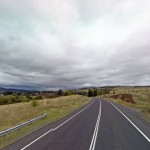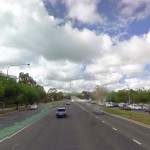We’ve put together a course for a three-week race that takes in some of the best roads in the country in an attempt to create cycling’s fourth Grand Tour: the Tour of Australia. We’re currently revealing one stage per day in the lead-up to Le Tour and this is stage 15.
Route: Bega to Canberra
Distance: 229km
Climbing: 2,500m
Click here to see the route on RideWithGPS, including the KOM and intermediate sprint points.
With the second and final rest day behind them, the riders have only six stages remaining before the Tour of Australia comes to a close. On stage 15 the riders start in the southern NSW town of Bega — just near the stage 14 finish in Tathra — and head north west into the ACT before ending the stage in Canberra.
The opening kilometres are more or less flat in the lead-up to the first intermediate sprint point of the day in Bemboka after 35km. A further 7km up the road the riders come across the first and only categorised climb of the day: the 1st-category ascent of Brown Mountain. All up it’s 10km of climbing at a touch under 8% with many sections that are considerably steeper than that.
It’s roughly 45km and generally downhill from the top of the climb to the town of Cooma at which point the riders head due north on the long run in to Canberra. There are a number of short rises and descents on this section of the Monaro Highway but no climbs significant enough to count as a categorised climb.
After 188km of racing, just past the small town of Williamsdale, the riders cross the border into the ACT. From here the riders continue along the Monaro Highway, approaching Canberra from the south and pushing through more short but relatively easy rollers.
After crossing the Molongo River — an extension of Lake Burley Griffin — after 222km of racing there’s only 7km left in the stage and the pace will certainly be on. The riders head north west along Morshead Drive alongside Kings Park and Lake Burley Griffin before taking a left turn onto Commowealth Avenue after 228km.
From here to the finish line it’s a dead straight, dead flat drag over Lake Burley Griffin and down the road towards Parliament House. The stage finishes roughly 100m before the State Circle which loops around Parliament House.
It’s hard to see this stage ending with anything other than a bunch sprint. You might expect to see the fast men fall away on the climb of Brown Mountain but with 160km from the summit to the stage finish, there’s more than enough time for the sprinters’ teams to take a breather before reeling in any breakaway that might have escaped (and one will have) and setting things up for a sprint finish in the nation’s capital.
Stay posted for stage 16 of the Tour of Australia, coming tomorrow.
Previous stages:
- Prologue: North Adelaide ITT
- Stage 1: Adelaide to Meningie
- Stage 2: Kingston SE to Horsham
- Stage 3: Horsham to Mt. William
- Stage 4: Halls Gap to Mt. Leura
- Stage 5: Peterborough to Torquay
- Stage 6: Lara to Yarra Glen
- Stage 7: Yarra Glen to Mt. Donna Buang
- Stage 8: Warburton to Mt. Baw Baw
- Stage 9: Traralgon to Bairnsdale
- Stage 10: Bairnsdale to Omeo
- Stage 11: Omeo to Mt. Hotham
- Stage 12: Bright to Albury
- Stage 13: Corryong to Perisher
- Stage 14: Perisher to Tathra


























Australia has a large number of climbs to a table land such as todays stage, think Dorrigo Falls, Gibralter Range, etc.
It has got me thinking, if there were to be a one-day race at UCI pro level similar to Grafton-Glen Innes, what would be the ideal length of flat to ride after a big climb that will give the sprinters a chance to catch the climbers, so a race would be won by a sprinter who can climb, a climber who can sprint or just dangle a carrot for the team of a big sprinter. I think the 1 min gap per 10km of road to go rule might apply.
Canberra has 5 really good conical peak climbs that are done as part of the Canberra 5 peaks ride every April: http://www.rotaryrides.org.au/site/index.cfm?fuseaction=display_main&OrgID=8242
There is also the Corin Dam climb and the amazing Fitzs challenge rides. Canberra is also equipped with some of the best bicycle infrastructure anywhere in the country.